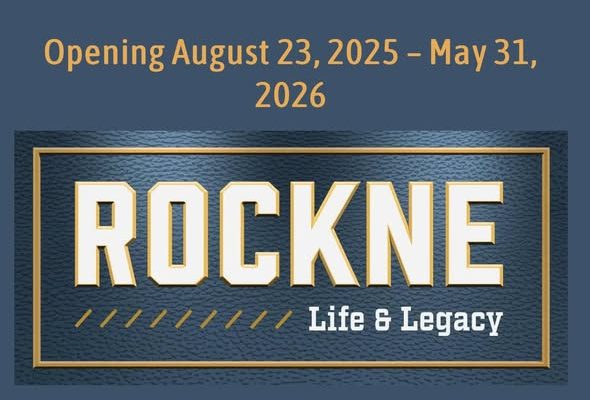The inclusion of Paul Kamish’s sculptures in the upcoming “Knute Rockne: Life & Legacy” exhibition at The History Museum in South Bend has already stirred interest among art lovers, sports historians, and those who understand the profound cultural resonance of Notre Dame’s most iconic football coach. Opening on August 23, the exhibit promises to do more than recount the achievements of Rockne the coach—it aims to portray Rockne the legend, Rockne the man, and Rockne the enduring symbol of perseverance, innovation, and American football’s golden age. And few artists are better suited to contribute to that portrayal than Kamish, whose work weaves athleticism, emotion, and narrative into forms that invite deep reflection.
Kamish’s participation in the exhibition is no coincidence. His sculptures, often imbued with movement and spirit, mirror the dynamism and influence Rockne exerted over college football and American culture. There is a particular harmony between Kamish’s medium and Rockne’s legacy. As a coach, Rockne was known for crafting cohesive, disciplined, and forward-thinking teams. As an artist, Kamish sculpts with intention, guiding the viewer’s eye and imagination through contours and expressions that are far from arbitrary. This synergy between subject and artist deepens the experience for anyone who views the exhibit—not merely as a sequence of historical displays, but as an immersive encounter with American heritage.
Knute Rockne was a figure who transcended the sport he helped define. Born in Norway and raised in Chicago, Rockne came to Notre Dame as a student in 1910. He would go on to revolutionize college football, introducing the forward pass as a dominant offensive weapon and leading the Fighting Irish to a record 105 wins, 12 losses, and 5 ties during his coaching tenure. He coached the fabled Four Horsemen and was responsible for turning Notre Dame into a national brand in college athletics. More than a football coach, Rockne became a cultural touchstone, known for his oratory, his vision, and the tragic plane crash that took his life at the age of 43 in 1931—an event that sent shockwaves through the nation and cemented his place in the pantheon of American icons.
Kamish’s sculptures serve as more than visual homage—they are three-dimensional conversations with history. For this exhibit, each piece functions as both artistic achievement and educational tool, encouraging viewers to not only see but to feel. The texture of a jersey rendered in bronze, the strain in a lineman’s neck, the quiet authority in Rockne’s gaze—all contribute to a multisensory experience that brings history palpably into the present. In many ways, Kamish is not simply creating sculptures of Rockne and the world he influenced; he is sculpting the public memory of those figures, giving form to the intangible.
To understand the depth of this exhibition, one must also appreciate Kamish’s broader body of work and artistic philosophy. Known for his commitment to realism laced with emotive energy, Kamish is no stranger to capturing iconic figures and moments. He often draws from themes of Americana, sports, and heroism, building visual narratives that offer viewers the chance to reflect on values like discipline, courage, and transformation. His work is never static; it invites movement, dialogue, and contemplation. This dynamic sensibility is particularly fitting for an exhibit centered on Rockne, a man who never stopped evolving as a coach, mentor, and public figure.
The History Museum in South Bend has long been a custodian of regional and national memory, and the Rockne exhibition is one of its most anticipated offerings in recent years. Located just miles from the University of Notre Dame campus, the museum is an ideal setting for a tribute of this scope. The decision to integrate Kamish’s work elevates the exhibition from being a mere collection of artifacts to a full-scale experiential narrative. Visitors can expect to see not only photographs, film reels, and memorabilia from Rockne’s era but also interpretive artworks that anchor those historical elements in the present day. It’s a conversation between past and future, with Kamish’s sculptures speaking volumes.
Part of what makes Kamish’s contribution so compelling is his ability to navigate the duality of Rockne’s legacy—the larger-than-life public figure and the private individual. Rockne was as much philosopher as he was tactician, known for galvanizing his players with speeches that touched on integrity, brotherhood, and the fleeting nature of opportunity. Kamish captures these nuances through sculpture, crafting not just portraits but emotional vignettes. A statue of Rockne on the sidelines, eyes fixed downfield, lips poised in mid-command, can convey more than a thousand words of text. It’s these moments—the ones in-between—that Kamish elevates to art.
This exhibition comes at a time when sports figures are being re-evaluated not just for their on-field achievements, but for their cultural impact. Rockne’s story, in many ways, mirrors the American dream: an immigrant who rose to prominence through hard work, innovation, and leadership. Kamish’s sculptures are thus not only representations of Rockne but also interpretations of what he symbolizes in a broader American context. They remind us that history is not static but ever-evolving, and that the way we remember our heroes speaks volumes about who we are and who we aspire to be.
Furthermore, the technical skill Kamish brings to the exhibition cannot be overstated. Working primarily in cast bronze and composite materials, he masterfully balances form and detail. His process is meticulous—beginning with sketches and maquettes before moving into full-scale models. Each phase is executed with attention to anatomical accuracy, emotional tone, and contextual relevance. When Kamish chooses to sculpt a facial expression, a posture, or a gesture, he does so with the weight of history behind it. His Rockne sculptures are not caricatures or idealized forms—they are studied representations that carry the authenticity of lived experience.
The decision to open the exhibit on August 23 is no accident either. That date is carefully chosen to align with the beginning of college football season, a time when interest in the sport surges and Notre Dame alumni around the world prepare to reconnect with their alma mater’s storied past. It is a season of renewal and reflection, both of which are captured in Kamish’s art. Through this timing, the museum cleverly ensures that the exhibition will have not just historical but emotional resonance, as generations of fans revisit the mythology of Rockne with fresh eyes and deeper appreciation.
While the exhibition focuses primarily on Rockne, Kamish’s work adds a layer of universality. His sculptures remind us that sports are not merely games, but expressions of human ambition, sacrifice, and connection. In the strained muscles of a tackle or the quiet posture of a coach in thought, Kamish encapsulates the human condition in a way that bridges disciplines and backgrounds. Even for visitors unfamiliar with Rockne or Notre Dame, the sculptures will speak a universal language of excellence, determination, and legacy.
There is also an educational dimension to Kamish’s involvement. Throughout the exhibition’s run, The History Museum plans to host a series of interactive workshops, artist talks, and guided tours that delve into both Rockne’s legacy and the artistic process behind the sculptures. Kamish is expected to participate in several of these events, offering rare insight into how history can be rendered in three dimensions. These educational efforts will engage students, families, and lifelong learners, ensuring that the exhibition extends its impact beyond the gallery walls.
What truly distinguishes this exhibition is the interplay between narrative and materiality. Kamish does not merely use sculpture as a decorative or illustrative tool; he uses it to interpret, to question, and to affirm. Each piece becomes a tactile repository of memory and meaning, offering viewers a chance to not just see history, but to touch it—emotionally and intellectually. For a figure as mythologized as Rockne, this physical proximity to his likeness adds an emotional gravity that printed texts or video clips simply cannot match.
As anticipation builds toward the August 23 opening, it becomes clear that this is not just another exhibit about a sports hero. It is a carefully curated tribute, shaped by the hands of an artist who understands that legacy is not built in a day, nor preserved by facts alone. It is forged through interpretation, reflection, and a deep respect for the subject matter. Paul Kamish, through his sculptures, has taken on the role of both artist and storyteller, giving us new lenses through which to view a figure who shaped not just a team or a university, but a national ethos.
In the weeks and months that follow, The History Museum’s halls will echo with stories—told not just through words, but through form, space, and expression. Visitors will come to learn about Rockne, but they will leave having witnessed something far greater: a collaboration between artist and legacy, between history and emotion. And at the center of it all will be Kamish’s sculptures, standing as both tribute and testament, ensuring that the legend of Knute Rockne continues to inspire future generations.



